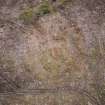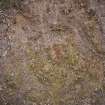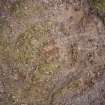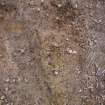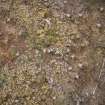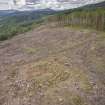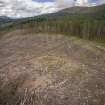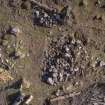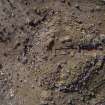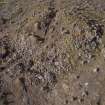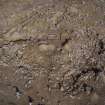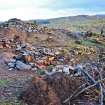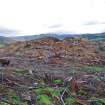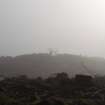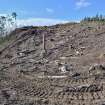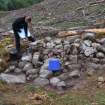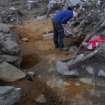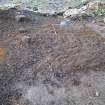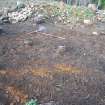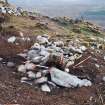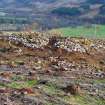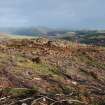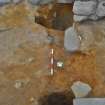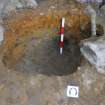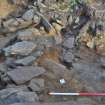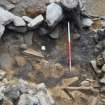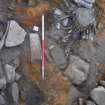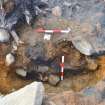Archaeological Evaluation
Date 9 September 2013 - 31 October 2013
Event ID 994045
Category Recording
Type Archaeological Evaluation
Permalink http://canmore.org.uk/event/994045
NH 32509 31008 An evaluation and measured survey were undertaken, 9 September – 31 October 2013, on a dun in Comar Wood, located 1km SW of Cannich in Strath Glass. The site was discovered during a pre-felling check on the woodland by Forestry Commission Scotland foresters. Located on a prominent knoll with extensive views over Strath Glass, the site consists of a dun with a well defined enclosure or defensive outwork. Later buildings of probable post-medieval date have been built into the rubble of the dun and outwork.
The main aims of the survey and evaluation were to: (i) record the site and to establish both the nature and extent of any surviving archaeological deposits and any damage caused by afforestation; (ii) securely date the site and better understand its form and function; (iii) enhance the historic environment record and forest design plan; and (iv) contribute to the Scottish archaeological research framework.
The dun consists of a massive stone-built sub-circular structure at least 21m in diameter over tumbled walls, up to 4m wide. The inner wall face of the dun would not have exceeded 1.5–2.0m in height and some sections of the exterior wall face must have stood to between 3–4m high. However, the walls of the dun have failed and collapsed, with the best-preserved sections now standing to a maximum of 0.8m high. Extensive damage from tree roots contributed greatly to the poor preservation of walling, with the outer wall face only partially surviving and no visible inner wall faces.
Excavations in the dun’s entrance passage recorded substantial postholes, some complete with packing stones, forming a roofed porch, a main post ring and an inner post ring to the structure. Deposits associated with the postholes and entrance portal provided evidence for intense burning, including some large fragments of vitrified stone. Sections of burnt roof timbers were also recovered along with ash deposits relating to the burning of peat or turf, which may provide evidence of a turf roof for the dun. The lowest course of stones in the entrance passage, substantially damaged by tree roots, indicated that the passage was lined with upright slabs.
The dun walls were evaluated and a trench on the E side of the structure, placed to investigate the walling and a possible intramural feature, revealed a well built outer wall face surviving up to 0.75m high. On the interior side of the trench, no clear evidence survived for an inner wall face or second wall. Although the deposits had been disturbed by tree root growth and movement, there did appear to be a possible intramural cell within the rubble-built walling. On the inside of the dun wall and overlying an earlier posthole, there also appeared to be an inner bank of stone relating to a secondary phase of use and restructuring.
A trench on the S side of the dun uncovered a surviving section of the outer wall, where an entrance through the wall had been blocked. The outer wall alignment on both sides of the entrance curved inward to this passage. There was also evidence for a possible outer wall or external structure around the blocked entrance, with steps leading to it. Further trenches evaluated the site’s outer enclosure wall and two of the post-medieval structures built into the W side of the dun.
Two clear phases of use were identified. An internal hearth consisted of a well-built stone setting with upright edge stones overlying two earlier hearth features. The earliest being a scoop in the natural subsoil that had been baked hard through use (and was filled with a reddish-coloured peat ash). This was overlain by the partially robbed out remains of a slab-built hearth and associated charcoal-rich deposits, over which had been built the final hearth. Some of the kerb stones surrounding the large upper slab-built hearth appeared to relate to the underlying robbed out hearth, while small post and stakeholes to the side of the hearth probably related to hearth 'furniture' for suspending cooking pots.
Few small finds were recovered and there was no pottery. A lower rotary quern stone had been incorporated into the slab construction of the upper hearth setting, along with a flat, polished rubbing stone; while a fragment of an upper rotary quern stone (including a central hopper-hole and off-set handle hole) was recovered from a linear stone setting to the S of the hearth. The remaining small finds consisted of one small fragment of sheet bronze with a small perforation hole and several small pebble tools. Samples suitable for radiocarbon dating, including charcoal and burnt bone were recovered. The dun appears to have been destroyed by fire during two phases of use, with areas of the underlying subsoil partially vitrified through the intense heat. Post-excavation analysis of the data and samples recovered will be undertaken prior to final reporting.
Archive: RoCAS. Report: Highland HER and OASIS (intended)
Funder: Forestry Commission Scotland
Steven Birch, Lynn Fraser, Cathy MacIvor, Mary Peteranna, Ross and Cromarty Archaeological Services, 2013
(Source: DES)









































































































